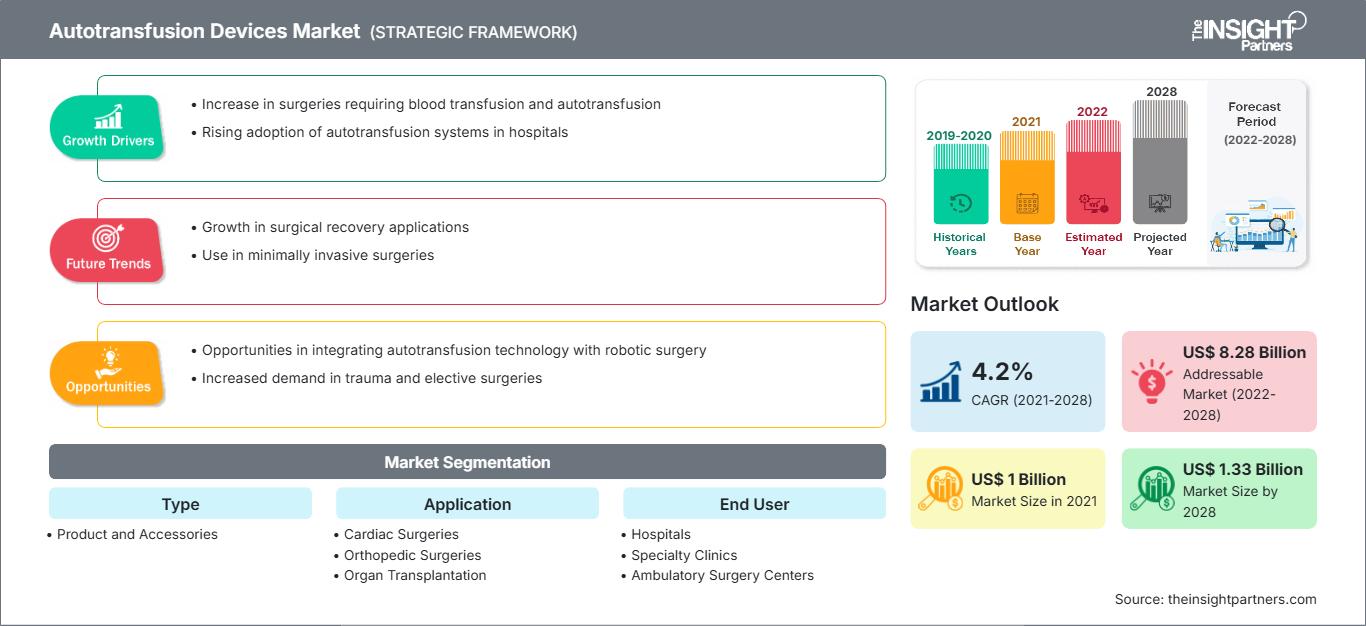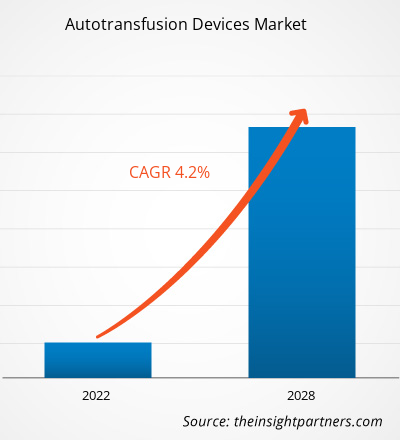Le marché des dispositifs d'autotransfusion devrait passer de 1 000,26 millions de dollars américains en 2021 à 1 331,99 millions de dollars américains en 2028 ; sa croissance devrait atteindre un TCAC de 4,2 % entre 2021 et 2028.
La transplantation d'organes est une intervention chirurgicale pratiquée en cas de défaillance d'organes. Elle concerne généralement des organes tels que le cœur, le foie et les reins. Cependant, face à l'augmentation des maladies chroniques, d'autres organes tels que les poumons, le pancréas, la cornée et les tissus vasculaires doivent être transplantés. Ces interventions durent généralement plusieurs heures et entraînent d'importantes pertes sanguines. L'autotransfusion est donc l'une des méthodes les plus efficaces pour prévenir les pertes sanguines. Selon le Réseau uni pour le partage d'organes (UNOS), les transplantations d'organes réalisées aux États-Unis sont en constante augmentation, avec plus de 41 000 transplantations réalisées en 2021. De même, selon les données du Registre mondial des transplantations, l'Espagne représentait 20 % de tous les dons d'organes dans l'UE en 2019 et 6 % des dons mondiaux. Le taux de dons d'organes en Australie s'est amélioré ces dernières années, atteignant 21,8 donneurs par million d'habitants en 2019.
Vous bénéficierez d’une personnalisation sur n’importe quel rapport - gratuitement - y compris des parties de ce rapport, ou une analyse au niveau du pays, un pack de données Excel, ainsi que de profiter d’offres exceptionnelles et de réductions pour les start-ups et les universités
Marché des dispositifs d'autotransfusion: Perspectives stratégiques

-
Obtenez les principales tendances clés du marché de ce rapport.Cet échantillon GRATUIT comprendra une analyse de données, allant des tendances du marché aux estimations et prévisions.
De même, le Canada compte 22,2 donneurs par million d'habitants et connaît une amélioration constante, en partie grâce au nombre de « médecins spécialistes des dons », c'est-à-dire les médecins de soins intensifs responsables des dons d'organes. Selon le Registre mondial des transplantations, la Chine comptait 5 818 donneurs en 2019, soit 4,1 par million d'habitants, et l'Inde 715 donneurs, soit 0,5 par million d'habitants. En revanche, la Russie affichait un taux légèrement supérieur de 5,1 donneurs par million d'habitants. Le partenariat public-privé, en collaboration avec les coordinateurs de transplantation, a contribué de manière significative à l'amélioration de la transplantation d'organes. Les pays en développement comme les pays développés ont constaté une augmentation des opérations de transplantation d'organes. Par exemple, des pays en développement comme l'Inde et Singapour émergent comme destinations de tourisme médical en Asie-Pacifique. Les pays progressent en termes de fourniture de traitements médicaux de meilleure qualité et plus avancés. Ainsi, le besoin croissant de transplantation d'organes est l'un des principaux facteurs à l'origine de la demande de diagnostics de transplantation tels que les dispositifs d'autotransfusion.
Le processus d'autotransfusion consiste à réinjecter le sang du patient. Le sang est prélevé dans la cavité péritonéale ou la région thoracique. Ce processus peut être réalisé avant, pendant et après l'intervention chirurgicale à l'aide du système d'autotransfusion. Les interventions médicales, telles que les arthroplasties, les chirurgies de la colonne vertébrale et les interventions cardiaques, entre autres, nécessitent l'autotransfusion. Elle contribue à réduire le risque d'infection et à éliminer les problèmes et complications liés à la conservation et à l'administration du sang de donneurs homologues. Elle contribue à prévenir la transmission de maladies transmissibles par le sang liées à la transfusion chez les patients.
Aperçu du marché : Développements technologiques dans les dispositifs d'autotransfusion
Les dispositifs d'autotransfusion sont généralement déployés lors d'interventions chirurgicales de longue durée, comme les transplantations rénales, et en cas d'urgence. Ces interventions chirurgicales sont associées à des risques de pertes sanguines excessives, ce qui rend difficile le rattrapage sanguin par du sang neuf, notamment en cas de groupes sanguins rares. Face à la forte demande, les principaux acteurs du marché des dispositifs d'autotransfusion proposent des dispositifs avancés et entièrement automatisés qui réduisent les interventions humaines. Par exemple, en avril 2021, le B-Capta de LivaNova PLC a été approuvé par la Food and Drug Administration (FDA) américaine. Lors des interventions chirurgicales complexes de pontage cardiopulmonaire chez l'enfant et l'adulte, ce dispositif permet une surveillance rapide et précise des paramètres veineux et des gaz du sang. De même, en avril 2019, BD a lancé son milieu de contrôle qualité BD BACTEC dans le monde entier pour faciliter l'identification des plaquettes contaminées lors des transfusions. De plus, de nombreuses entreprises ont mis en œuvre des stratégies telles que des acquisitions, des partenariats et autres pour conquérir le marché. Par exemple, Medtronics a acquis AV Medical Technologies en octobre 2019. En décembre 2019, Getinge a racheté Applikon Biotechnology, leader mondial du développement et de la fourniture de systèmes de bioréacteurs innovants, du laboratoire à l'échelle industrielle. Ainsi, ces avancées sont susceptibles d'apporter de nouvelles tendances sur le marché des dispositifs d'autotransfusion dans les années à venir.
Informations basées sur les applications
En fonction des applications, le marché des dispositifs d'autotransfusion est segmenté en chirurgies cardiaques, chirurgies orthopédiques, transplantation d'organes, interventions traumatologiques, etc. Le segment des chirurgies cardiaques détenait la plus grande part de marché en 2021, tandis que le segment de la transplantation d'organes devrait également enregistrer le TCAC le plus élevé du marché au cours de la période de prévision.
Les acteurs du marché des dispositifs d'autotransfusion adoptent des stratégies organiques telles que le lancement et l'expansion de produits pour étendre leur présence et leur portefeuille de produits à l'échelle mondiale et répondre à la demande croissante. Les développements des entreprises sur le marché des dispositifs d'autotransfusion se caractérisent par des développements organiques et inorganiques. Plusieurs entreprises privilégient des stratégies organiques, telles que le lancement et l'expansion de produits. Les stratégies de croissance inorganiques observées sur le marché des dispositifs d'autotransfusion reposent sur des partenariats et des collaborations. Ces stratégies ont permis aux acteurs du marché de développer leurs activités et d'améliorer leur présence géographique. De plus, des stratégies de croissance telles que les acquisitions et les partenariats ont permis de renforcer leur clientèle et d'élargir leur portefeuille de produits. Les entreprises ont maximisé leur croissance grâce à plusieurs stratégies inorganiques afin d'améliorer la valeur et le positionnement des dispositifs d'autotransfusion sur le marché. Les développements organiques représentent 66,67 % du total des développements stratégiques sur le marché des dispositifs d'autotransfusion, tandis que les stratégies inorganiques représentent 33,33 % de la croissance des entreprises.
Le marché des dispositifs d'autotransfusion est segmenté comme suit :
Le marché des dispositifs d'autotransfusion est segmenté en fonction du type, de l'application et de l'utilisateur final. Selon le type, le marché des dispositifs d'autotransfusion se divise en produits et accessoires. Selon l'application, le marché des dispositifs d'autotransfusion est segmenté en chirurgies cardiaques, chirurgies orthopédiques, transplantations d'organes, interventions traumatologiques, etc.
Le marché des dispositifs d'autotransfusion, selon l'utilisateur final, est divisé en hôpitaux, cliniques spécialisées et centres de chirurgie ambulatoire.
Aperçu régional du marché des dispositifs d'autotransfusion
Les tendances régionales et les facteurs influençant le marché des dispositifs d'autotransfusion tout au long de la période de prévision ont été analysés en détail par les analystes de The Insight Partners. Cette section aborde également les segments et la géographie du marché des dispositifs d'autotransfusion en Amérique du Nord, en Europe, en Asie-Pacifique, au Moyen-Orient et en Afrique, ainsi qu'en Amérique du Sud et en Amérique centrale.
Portée du rapport sur le marché des dispositifs d'autotransfusion
| Attribut de rapport | Détails |
|---|---|
| Taille du marché en 2021 | US$ 1 Billion |
| Taille du marché par 2028 | US$ 1.33 Billion |
| TCAC mondial (2021 - 2028) | 4.2% |
| Données historiques | 2019-2020 |
| Période de prévision | 2022-2028 |
| Segments couverts |
By Type
|
| Régions et pays couverts |
Amérique du Nord
|
| Leaders du marché et profils d'entreprises clés |
|
Densité des acteurs du marché des dispositifs d'autotransfusion : comprendre son impact sur la dynamique commerciale
Le marché des dispositifs d'autotransfusion connaît une croissance rapide, portée par une demande croissante des utilisateurs finaux, due à des facteurs tels que l'évolution des préférences des consommateurs, les avancées technologiques et une meilleure connaissance des avantages du produit. Face à cette demande croissante, les entreprises élargissent leur offre, innovent pour répondre aux besoins des consommateurs et capitalisent sur les nouvelles tendances, ce qui alimente la croissance du marché.

- Obtenez le Marché des dispositifs d'autotransfusion Aperçu des principaux acteurs clés
- Analyse historique (2 ans), année de base, prévision (7 ans) avec TCAC
- Analyse PEST et SWOT
- Taille du marché Valeur / Volume - Mondial, Régional, Pays
- Industrie et paysage concurrentiel
- Ensemble de données Excel
Rapports récents
Témoignages
Raison d'acheter
- Prise de décision éclairée
- Compréhension de la dynamique du marché
- Analyse concurrentielle
- Connaissances clients
- Prévisions de marché
- Atténuation des risques
- Planification stratégique
- Justification des investissements
- Identification des marchés émergents
- Amélioration des stratégies marketing
- Amélioration de l'efficacité opérationnelle
- Alignement sur les tendances réglementaires






















 Obtenez un échantillon gratuit pour - Marché des dispositifs d'autotransfusion
Obtenez un échantillon gratuit pour - Marché des dispositifs d'autotransfusion